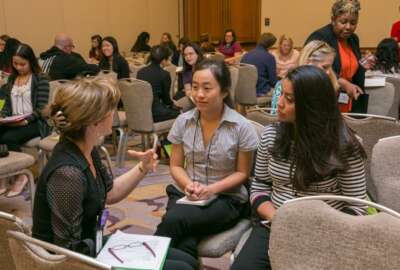A tough picture emerges for women veterans
Women veterans, who were wounded or injured, are more likely, compared to men, to have post traumatic stress disorder and to die by suicide. That is according to...
Women veterans, who were wounded or injured, are more likely, compared to men, to have post traumatic stress disorder and to die by suicide. That is according to the Wounded Warrior Project, which surveyed 18,000 male and female veterans. For more on the survey, the Federal Drive with Tom Temin spoke with Tracy Farrell, VP of the Project.
Interview Transcript:
Tom Temin And what were you looking at here and how did you go about finding this information?
Tracy Farrell So, you know, it’s amazing to me. And I served for 22 and a half years, but women represent the fastest growing population in the military and the veteran communities. And yet time after time, we’re hearing that women, as they transition from service, don’t have the support in their communities that they need in order to thrive as a civilian. And so we took information from our annual Warrior survey, which we do every other year, and have 5000 responses from women. And then we called through those responses and found, as you said, that there’s some specific challenges that women face with regards to financial wellness, access to care, mental illness, social health, military transition and military sexual trauma. And from that, we showed in this report, which is available online on our website, what those differences were. And we made some recommendations on the way forward.
Tom Temin All right. And so I guess these recommendations in many ways fall on the Veterans Affairs Department and the Veterans Health Administration.
Tracy Farrell That and I would say with regards to transition programs, a matching up of DoD and VA as well as political appointees and representatives, there’s some policy recommendations as well. And then, as always, Wounded Warrior Project is a veteran service organization, a nonprofit, and we have recommendations for our peers in that space as well.
Tom Temin And just some of the details of the findings with respect to mainly suicide, which is just a persistent and terrible issue that VA and so many organizations have been trying to deal with in their own different ways. What is the fact there that you found with respect to female veterans that were injured or wounded?
Tracy Farrell Wounded Warrior Project Women warriors are more likely to present with moderate to severe symptoms of post-traumatic stress, depression and anxiety than their male peers, and the rates of suicidal ideation and the prevalence of at least one attempted suicide, as you mentioned, are higher in women warriors than in their male warriors. So access to care is something that we really focus on. Is the VA manned and able to give the mental health treatment that is required? Do we take away the barriers to care such as child care or hours of operation or telehealth? You know, a lot of people have embraced telehealth after COVID, and we see that women have taken that on an uptick higher than men. So with regard to mental illness, we’re just looking at how do we better serve them and how do we ensure that women are on their feet as they engage in their communities?
Tom Temin And looking at some of the survey results from a standpoint of where people served, the bulk, almost two thirds, 61%, were Army veterans. And in the last 20 years, it is Army that has taken the brunt of activities overseas that the United States has been engaged in. Only 18% of your respondents were Navy and, you know, a small percentage and Coast Guard, 17% in Air Force. So they’re more likely to be injured, at least in the last 20 or so years of experience by virtue of being in the Army.
Tracy Farrell Mm hmm. That’s absolutely right. But we also see military sexual trauma does not identify along specific service identification. And so that’s an area that we’ve looked at over the years and how best to serve women warriors who experience MST. And again, that goes back to access to care and ensuring sensitivity within the VA and within those who serve women and men with military sexual trauma so that they don’t have to keep on reliving their story and can get on the path to healing.
Tom Temin In some ways, the sexual trauma is the worst kind of injury because it is inflicted by people you expect to be comrades.
Tracy Farrell That’s what we hear quite often Tom from those we serve.
Tom Temin We’re speaking with Tracy Farrell. She’s vice president for partnerships and operations at the Wounded Warrior Project. Well, given these findings that, you know, women maybe have a worse time of it post-military. What are your main recommendations and for whom?
Tracy Farrell Sure. So I think first and foremost is that first step of transition. The military to the civilian transition process must be enhanced and include ongoing support. You know, when I transitioned from the military, I thought I was just going to take off my military uniform and then the next day be this glorious civilian in the world. And I may have been. But in my own eyes, it wasn’t quite there yet. It took me quite a few months to get accustomed to not being in the military anymore, to making sure I had my resume in line. And to connecting with other veterans.
Tom Temin And just a brief question there. You mentioned you were in for 22 years career, really. Is there a difference, do you think, between people that might enlist, do their two or four years and then get out versus people that had a career where you were in uniform for, you know, a long time?
Tracy Farrell I think there’s two areas where there’s differences. One is that of going in and coming out with perhaps not a college education, but deciding to go on for further education or perhaps going in at 18 vs. 22 when I went into after college age. Right. And your formative years are in the military. But I think the other thing that we find because Wounded Warrior Project serves individuals who have been wounded or injured concurrent with their service is a difference between getting out on your own terms or getting out because the military tells you to, because you’re injured and can no longer serve. Many of the warriors I talked to thought this was going to be a career for them. They’ve really enjoyed what they were doing in serving their nation. And then when they were injured, they couldn’t do that anymore. And so that plan to stay in forever or for 20 or some years fell away from them and they didn’t have a backup plan. And so that’s the bigger differentiator, I think.
Tom Temin All right. And briefly, the transition services provided by the military, we often hear they could be a little bit stronger. Was that your experience?
Tracy Farrell That was my experience as well. And I think they’ve come a long way. In fact, I know they have, because I follow what they’re doing and they’ve developed some internship processes. They’ve focused more on collaboration with the VA. But I do think, especially with regards to women, I think a supplemental track during this transition program that focuses on gender specific health care benefits and services available to women veterans in their communities would benefit all of the women transitioning. Women just don’t know what’s in their communities when they transition and them being 10% right now of the veteran population, that’s a small amount. We’re going to grow to 18% by 2040, which is larger. But we have to ensure that women veterans are aware of the support that’s out there for them.
Tom Temin And all those VFW halls are going to have to accommodate themselves, I think, as the years go by. And anyway, we were talking about recommendations before I interrupted you. What about for Veterans Affairs? Because they’ve made a lot of progress to increase treating women over the past couple of decades.
Tracy Farrell They have done so much in the past years to establish some women health clinics, expand their offerings with regards to women’s health care, but it’s not prevalent across the country. So we need as a nation to continue to leverage community based resources and telehealth, as I mentioned before, to address some of the barriers of care that women experience.
Tom Temin And for employers who want to hire veterans or might be required to hire veterans under some federal contract, and for federal agencies that often prefer to hire veterans. What should those people know that are not care providers but are job providers? And presumably they want people to succeed?
Tracy Farrell Sure. I think there’s a couple of things we need to somehow still have a stigma about veterans having PTSD in the workplace, and that should be addressed. Right. And so I think embracing the qualities of goodness, the qualities of leadership, the qualities of followership, and the qualities of initiative that the military imbues in that population is really important. And don’t look just at the resume, but look at what the person offers. And there’s tons of organizations helping veterans get jobs so connect with them.
Tom Temin And there is one former military officer out there and he’s written a book of Bill Tohti just simply saying don’t hire because of perceived leadership skills in the military, but rather because of skills, skills, things you can actually do. And not to presume everybody is going to be a commanding general type of person just because they’re a veteran. I mean, that’s offers up a bad stereotype, too, isn’t it?
Tracy Farrell Yeah, it is. And in fact, I was a military police officer and a lot of the men and women that left my command wanted to go work in the police force or the FBI or the CIA. And we’re able to use the skill sets that they learned as military police, whether it be investigators or patrols or even overseas, to benefit their communities in that capacity.
Tom Temin And just briefly, what are you doing with this report? I mean, it comes out every couple of years. It’s comprehensive. There’s, you know, 40 pages of findings here. Who should read it and how are you getting it out there?
Tracy Farrell A couple of weeks ago on the launch of the report, we brought 50 women warriors to Capitol Hill and visited with those ladies, representatives and the congressmen and just talked about the challenges that they were having. And the report is available online. And so it’s accessible to anybody who would like to look at it. It’s at Wounded Warrior Project dot org, and we’re sharing it widely with the general public, with veterans’ service organizations, with the VA and with DoD as interested so that they can hear what’s happening to women warriors across our nation.
Copyright © 2025 Federal News Network. All rights reserved. This website is not intended for users located within the European Economic Area.
Tom Temin is host of the Federal Drive and has been providing insight on federal technology and management issues for more than 30 years.
Follow @tteminWFED






